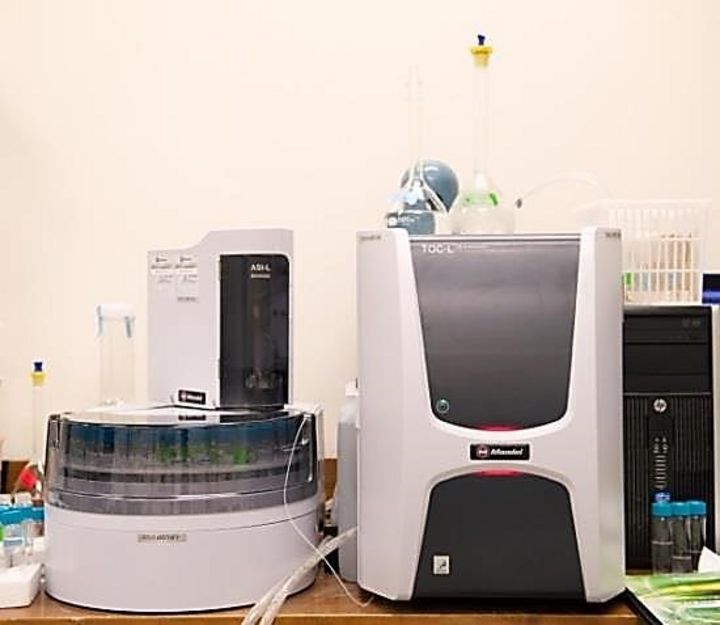
Laboratory dedicated to the maintenance of active strains of algae under the daily supervision of a student assistant. AlgaFuelTM pilot pond with vertical and horizontal agitation of 10 cubic meters for the intensive cultivation of microalgae in industrial waste water for energy purposes. This basin is configured to ensure perfect homogenization of the algal suspension and maximize the productivity of microalgae in terms of cell density (and generally oils) under predominantly heterotrophic culture conditions. The basin can be used for the treatment of wastewater by microalgae. The basin has recently been equipped with a Bio-Intelligence probe for advanced monitoring of cell growth and the production of various metabolites by microalgae.

- Atomic absorption spectrophotometer (flame and graphite furnace)
- Automated titrator and Karl Fisher
- Capillary electrophoresis
- Differential Scanning Calorimeter (DSC)
- Fluorescence Spectrometer X (XRF)
- FTIR infrared spectrometer with cell specialized in gas and biogas analysis
- Fluorimeter
- Gas chromatograph (GC-TCD) for gas analysis
- Gas chromatograph (GC-FID)
- FTIR Infra-Red Spectrometer For Solid And Liquid Samples
- Ion chromatography
- Gas chromatograph combined with a mass spectrometer (GC-MS)
- High-performance liquid chromatography combined with an ion-trap mass spectrometry (LC-MS)
- High-Performance Liquid Chromatography (2 Units, One Of Which Is Equipped With A Fraction Collector)
- High-Performance Liquid Chromatograph With An ELSD Detector (Electrospray Light Scattering Detector)
- Kjeldahl analyzer (total nitrogen and ammonia)
- Spectromètre d’émission optique muni d’un plasma à couplage inductif (ICP-OES)
- Thermogravimetric analyzer coupled with mass spectrometer (TGA-MS)
- Total organic carbon analyzer
The infrastructure consists of a Siemens SOMATOM Definition AS + 128 CT scanner, a data processing and storage unit, a sedimentology laboratory, and hydraulics, bio-sedimentology and hydrology equipment. The scale of this infrastructure is unique in Canada and in a class of its own worldwide.
- Gas chromatography and mass spectrometry
- Ion chromatography
- Atomic absorption spectrometry with flame
- Zetameter
- Infrared spectroscopy
- Total organic carbon analyzer
- High performance liquid chromatography
- UV-Visible spectrophotometer
- Solid phase extraction equipment for hydrocarbons
- Basic analytical equipment
- Oil & grease analyzer
- Activated carbon adsorption column
- Column for aeration tests
- Respirometer
Confocal microscopy and flow cytometry laboratoryThe laboratory is equipped with a four-laser LSRFortessa cytometer that allows high-level multiparametric analyzes to characterize cell populations. A BD FACS Calibur two-laser cytometer is used to perform routine analyzes such as the expression of surface markers. The Zeiss LSM780 confocal microscopy system is a state-of-the-art instrument for the study of various cellular and subcellular biological processes such as intracellular trafficking and localization of pathogen molecules.
The Laboratory for Ecotoxicogenomics and Endocrine Disruption (LEPE) brings together the expertise, knowledge, infrastructure and instrumentation necessary to test the effects of contaminants on the health of living organisms. The experiments are carried out in the laboratory, in microcosm, in mesocosm and in the field. The team is developing unique biomarkers for each target species in order to understand and validate the mechanisms of action of contaminants. The group also specializes in the study of endocrine disruptors and has, among other things, ultra-sensitive cell lines that identify contaminants capable of altering the hormonal response.
This pilot laboratory provides the scientific community and industry with its multidisciplinary expertise and state-of-the-art equipment for the development and scaling of fermentation processes as well as the recovery, purification and characterization of various microbial derivatives. Its primary purpose is R & D in the field of biotechnology, and especially value-added products using putrescible residues as raw material.
The researchers at the Environmental Engineering Laboratory are tasked with acquiring knowledge to improve the quality of the environment. In particular, they work in two major areas of research, namely the development of innovative environmental technologies for the rehabilitation of contaminated environments, and the characterization of contaminated environments.
This pilot laboratory is a powerful, mobile and flexible infrastructure for testing and demonstrating, at low cost, and directly in industrial environments or on degraded sites, new remediation and decontamination processes before their implementation on a real scale. . The laboratory team works to develop technologies for the treatment, decontamination and recovery of various matrices polluted by metals and other types of pollutants. The development of processes contributing to sustainable development in the field of environmental technologies is a priority research area of the INRS. The laboratory has a multifunctional mobile pilot plant to operate various types of physical, chemical and biological processes for the treatment of soils, hazardous wastes, gases, as well as industrial residues and effluents directly on contaminated sites.
/// Features:
- Processing volume: 1 to 4 L
- Operating pressure up to 600 psi
- Feed flow ranging from 1 L/min to 6 L/min
- Membrane coupons for MF, UF, NF, and OI
- Can be adapted to forward osmosis
/// Samples:
- Liquids: effluents, residual liquids, process waters, fluids, etc.
/// Examples of applications
- Scanning and selection of the type of membrane to be used
- Optimization of membrane filtration parameters: flow, pressure, temperature
- Studies of the effects on liquids and membranes (precipitations, clogging, pressure drop, etc.)